Plants play an integral role in our daily lives, not only enhancing our surroundings with their beauty but also providing essential oxygen and, in some cases, nourishment. Embracing the concept of a “Planterij,” a space dedicated to the cultivation and care of plants, offers a multitude of rewards. Whether you’re a seasoned gardener or just starting out, building and maintaining a thriving planterij can transform your home or community, fostering both environmental and personal growth. This guide will walk you through the essential steps of creating a successful planterij, from understanding plant growth fundamentals to exploring innovative gardening techniques.
Understanding the Basics of Plant Growth in Your Planterij
The Importance of Photosynthesis
At the heart of every successful planterij lies photosynthesis, a process crucial to plant growth and the well-being of our planet. Photosynthesis enables plants to convert sunlight into chemical energy, powering their growth and producing oxygen as a byproduct. Through the green pigment chlorophyll, plants absorb sunlight and, using carbon dioxide and water, generate glucose, a form of sugar that fuels their development. The oxygen released during this process not only sustains plant life but is also essential for human and animal survival. Thus, photosynthesis in a well-maintained planterij directly contributes to a healthier environment by purifying the air and supporting life.
By ensuring that your planterij is positioned in a location with optimal sunlight exposure, you can maximize the photosynthetic activity of your plants. Understanding the balance between light and shadow, especially for indoor planterijs, is key to encouraging healthy plant growth and maintaining an oxygen-rich space.

Essential Nutrients and Soil Health
A strong foundation for any planterij begins with nutrient-rich, well-balanced soil. Just as humans need a variety of nutrients to thrive, plants rely on specific elements for growth, namely nitrogen (N), phosphorus (P), and potassium (K), which are the three primary macronutrients. In addition, plants also require micronutrients such as calcium, magnesium, and iron for their development and overall health. In your planterij, it’s vital to ensure that the soil remains rich in these essential nutrients, as depleted soil can lead to stunted growth and ailing plants.
To foster healthy plant life in your planterij, regularly enrich the soil with compost or organic matter. These additions improve soil structure, enhance water retention, and promote beneficial microbial activity. Periodically testing the soil’s pH levels and nutrient content ensures that it stays balanced, supporting continuous growth. By providing your plants with the proper soil composition, you set the stage for a lush and flourishing planterij.
Watering and Drainage for Optimal Plant Health
Watering is one of the most crucial aspects of maintaining a healthy planterij. Each plant species has its own unique water requirements, and it’s important to strike a balance between over-watering and under-watering. Over-watering can lead to root rot and other fungal diseases, while insufficient water can result in dehydration and wilting. To prevent these issues, it’s essential to understand the specific needs of the plants in your planterij.
In addition to proper watering techniques, effective drainage is equally important for plant health. Soil that retains too much moisture can suffocate plant roots, preventing them from accessing oxygen. To ensure your planterij’s success, choose pots with drainage holes, incorporate perlite or sand to improve soil aeration, and avoid waterlogging the soil. Monitoring moisture levels with a soil moisture meter can help you maintain a consistent and healthy watering schedule for your planterij.
Setting Up a Successful Planterij
Choosing the Optimal Location for Your Planterij
The location of your planterij plays a pivotal role in the overall health and growth of your plants. Depending on whether you are cultivating an outdoor garden, an indoor plant collection, or a greenhouse, selecting a site that receives adequate sunlight is essential. Most plants require at least six hours of direct sunlight per day to thrive, so choose a spot that meets these light requirements. For indoor planterijs, positioning plants near south-facing windows or supplementing with artificial grow lights can help mimic the natural sunlight necessary for photosynthesis.
In addition to light, consider other environmental factors such as wind exposure, temperature fluctuations, and humidity levels when selecting the location for your planterij. Understanding the specific needs of the plants you’re growing will help you create an environment that promotes their growth and well-being.
Selecting the Best Plants for Your Planterij
Choosing the right plants for your planterij is critical to its long-term success. When selecting plants, it’s important to consider the climate, soil conditions, and available sunlight in your planterij’s location. Research your region’s hardiness zone to identify plants that are naturally suited to your environment. For beginners, starting with hardy, low-maintenance plants like succulents, ferns, or herbs can be a great way to gain confidence and develop your gardening skills.
Additionally, consider the purpose of your planterij. Are you looking to create a decorative space filled with vibrant flowers, or do you want to grow your own food by cultivating vegetables and herbs? Understanding the function of your planterij will guide your plant selection, ensuring that you create a space that meets your needs and aesthetic preferences.
Designing a Functional and Aesthetic Plant Layout
Creating an effective plant layout is essential for the health and productivity of your planterij. When arranging plants, take into account their mature size, growth habits, and light requirements to ensure each one has the space and resources it needs to thrive. Taller plants should be placed at the back or center of your planterij to avoid shading smaller plants that require more light. Similarly, shade-loving plants should be positioned in areas with indirect sunlight, while sun-loving plants should be placed in areas with full sun exposure.
Incorporating companion planting, where certain plants are grown together for mutual benefit, can enhance the overall health and yield of your planterij. For example, pairing plants that repel pests with those that attract beneficial insects can create a natural balance and reduce the need for chemical pesticides. A well-planned layout not only maximizes the use of space but also creates a visually appealing and harmonious planterij.

Planterij Care and Maintenance Strategies
Mastering Fertilization Techniques for a Thriving Planterij
Fertilization is key to providing plants with the nutrients they need to grow strong and healthy. Organic fertilizers, such as compost, manure, and bone meal, offer a natural way to enhance soil fertility without introducing harmful chemicals into the environment. Chemical fertilizers, on the other hand, provide precise nutrient ratios tailored to specific plant needs but should be used with care to avoid over-fertilization, which can damage plant roots and soil health.
To maintain a thriving planterij, follow the recommended guidelines for fertilizing each type of plant and adjust your fertilization schedule based on the growing season. During periods of active growth, such as spring and summer, plants may require more frequent feeding, while in fall and winter, fertilization can be reduced.
The Importance of Pruning and Deadheading
Regular pruning and deadheading are essential practices for maintaining a healthy and attractive planterij. Pruning involves trimming back overgrown or damaged branches to improve a plant’s structure and promote new growth. Deadheading, the removal of spent flowers, encourages plants to produce more blooms and prevents them from going to seed too early.
In addition to promoting plant health, these practices enhance the overall appearance of your planterij by keeping plants neat and vibrant. For fruit-bearing plants, pruning can increase fruit production by allowing more sunlight to reach the inner branches and improving air circulation.
Effectively Managing Pests and Diseases in Your Planterij
Pests and diseases can quickly damage or destroy plants if left unchecked. To protect your planterij, regularly inspect plants for signs of trouble, such as yellowing leaves, holes, or mold. Early detection is key to preventing infestations from spreading and causing significant harm.
Integrated Pest Management (IPM) is a holistic approach to controlling pests that combines cultural, biological, and mechanical methods. Rather than relying solely on chemical pesticides, IPM encourages natural solutions like introducing beneficial insects, using organic sprays like neem oil, and practicing crop rotation to minimize pest populations. By using these environmentally friendly methods, you can maintain a healthy planterij while reducing your impact on the surrounding ecosystem.

Seasonal Care Tips for Your Planterij
Spring: The Season for New Growth
As temperatures rise and days grow longer, spring is a time of renewal in your planterij. This is the ideal season to sow seeds, transplant seedlings, and prepare your planterij for the growing months ahead. Begin by cleaning up any debris left over from winter and amending the soil with fresh compost or organic matter to enrich its nutrients.
Spring is also a time to plan your planting schedule, considering the specific needs and growing times of each plant. By starting early and giving your plants a strong foundation, you set the stage for a bountiful planterij throughout the year.
Summer: Managing Heat and Pests
Summer’s heat can be both a blessing and a challenge for your planterij. While plants enjoy the warmth, they may also require more frequent watering to prevent dehydration. Applying mulch around the base of plants helps retain moisture in the soil and keeps roots cool. Summer is also a peak season for pests, so regularly inspecting your planterij and using natural pest control methods will help keep unwanted visitors at bay.
Autumn: Preparing for Colder Weather
As the days shorten and temperatures drop, autumn is the time to prepare your planterij for the colder months ahead. Begin by pruning back perennials, removing dead leaves, and applying a thick layer of mulch to insulate plant roots from frost. Dividing and replanting perennials can also give them a fresh start for the next growing season. For tender plants that can’t survive the cold, consider bringing them indoors or covering them with protective row covers.
Winter: Protecting Plants from Frost
Winter presents unique challenges for plant care, especially in frost-prone regions, where cold temperatures can severely damage or kill sensitive plants. To safeguard your planterij, several strategies can be employed to ensure plant health through the colder months. Row covers and cloches provide lightweight, protective barriers that trap warmth around plants, while mulching insulates plant roots and maintains soil moisture. Greenhouses or cold frames offer an enclosed, regulated environment for delicate plants. Watering should be reduced in winter to avoid root rot, but occasional deep watering may be necessary during dry spells. Bringing potted plants indoors or using frost blankets are also effective ways to protect against frost damage. With these precautions, your planterij will not only survive winter but emerge strong and ready for spring growth.
FAQs About Planterij
Q: What is the best type of soil for a planterij?
A: The best soil for your planterij depends on the plants you’re growing, but generally, a well-draining, nutrient-rich soil is ideal. Adding compost or organic matter improves soil structure, boosts nutrient content, and helps retain moisture, providing a strong foundation for healthy plant growth.
Q: How often should I water my planterij?
A: Watering needs vary based on plant type, soil condition, and season. Typically, plants require more water during hot months and less during their dormant phases in colder months. It’s important to avoid overwatering, which can lead to root rot, and ensure that your planterij has proper drainage.
Q: Can I grow a planterij indoors?
A: Yes! Indoor planterijs are a great way to bring nature into your home. Be sure to place your plants near a window with plenty of sunlight or use grow lights to replicate natural conditions. Choosing plants that thrive in indoor environments, such as succulents or ferns, is also important for success.
Q: How do I protect my plants during winter?
A: To protect plants during the winter, use frost blankets, row covers, or cloches to trap warmth around your plants. Mulching can also help insulate plant roots, and for potted plants, bringing them indoors is an effective way to safeguard them from cold temperatures.
Q: What is companion planting, and how does it benefit my planterij?
A: Companion planting involves growing certain plants together that benefit each other by repelling pests, improving soil health, or enhancing growth. For example, planting marigolds near vegetables can help deter harmful insects, promoting a healthier planterij.
Conclusion
A planterij is a dedicated space for nurturing plants, offering environmental, aesthetic, and personal benefits. To create a thriving planterij, understanding the basics of plant growth—such as photosynthesis, soil health, and proper watering—is essential. Whether cultivating an indoor or outdoor planterij, selecting the right plants and optimizing their environment are key factors for success. Seasonal care, including spring planting, summer pest management, and winter frost protection, ensures year-round plant health. By applying the right techniques, from mulching and pruning to effective fertilization, your planterij will flourish, providing beauty, sustenance, and a connection to nature.
Read Next: faqlogin-com-home-improvement

